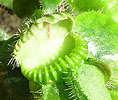![]()
(Cephalotus | Darlingtonia | Dionaea | Drosera | Genlisia | Heliamphora | Nepenthes | Pinguicula | Sarracenia | Utricularia)
![]()
Common Name: Australian Pitcher Plant or The Albany Pitcher Plant
Click on the thumbnail image to see the full picture.
Cephalotus follicularis
| Family Name: | Cephalotaceae |
| Location: | Found only in south western region of Western Australia |
| Number of Species: | 1 species Cephalotus follicularis (monotypic genus) |
Trap Method: |
Passive |
| Trap type: | Pitfall trap |
Cephalotus plants grow in the form of clusters of small pitcher traps and non carnivorous oval leaves which grow from a rhizome. The plants generally form a rough rosette shape and can vary in colour from green to a deep burgundy red colouration if grown in full sunlight
The pitchers on the plant form facing away from the centre of the cluster with the lid closed, and when the pitcher develops full size the lid opens and remains open for the life of the pitcher. The pitcher lid has a pattern of small translucent windows.
Trapping Mechanism: Passive Pitfall trap
 The inward turned spines on the rim of each pitcher (pictured at left) may serve to guide prey into the trap and make it difficult for insects to escape once they have entered. Nectar glands are present in a collar around the rim, and digestive glands are located within the pitcher; it is usual to find a small quantity of fluid within active growing pitchers. As with many species that employ pitfall traps the inner surface of the pitcher is slippery to prevent prey climbing to escape.
The inward turned spines on the rim of each pitcher (pictured at left) may serve to guide prey into the trap and make it difficult for insects to escape once they have entered. Nectar glands are present in a collar around the rim, and digestive glands are located within the pitcher; it is usual to find a small quantity of fluid within active growing pitchers. As with many species that employ pitfall traps the inner surface of the pitcher is slippery to prevent prey climbing to escape.
Can be quite difficult to grow in cultivation. Plants are very prone to rotting and fungal attack if the soil is too wet, and it is best to avoid watering the plant from above, instead watering from below with the plant standing in a tray or saucer.
Reduce water in the winter months.
After suggestion on the CPUK forum I have tried innoculating the soil mixture with Trichoderma, a fungal species which can be commercially obtained and which appears to out-compete and suppress other pathogenic fungi. Since then I have not lost a single plant, but I have not carried out any trials and cannot be certain that this is anything more than coincidence.
%20-%20010%20(crop).jpg) Rhizome cutting
Rhizome cutting
Leaf cutting (pictured at left)
Seed

last
updated 30-Mar-2008
Home | Carnivorous Plants | Other Plants | Roman | Neolithic | Wildlife | Cats | Scenery | Links
All photos were taken with a Minolta Dimage F200 (4.0 Megapixel) or Nikon D50 (6.1 Megapixel) Digital camera unless otherwise noted. All photographs, illustrations and content copyright © 2004-2008 Janet & Iain Clark. If you wish to use our images please feel free to contact us (do not re-use images without express permission).



.jpg)
.jpg)
.jpg)
.jpg)